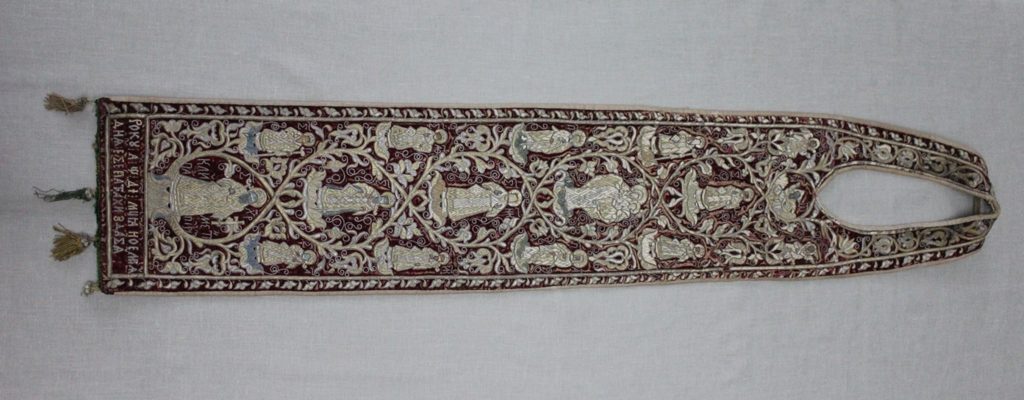At the Chernihiv Historical Museum named after VV. Tarnowski has a unique collection of clothes from different segments of the population: this is a traditional Ukrainian folk costume, clothes of the Cossack sergeant, citizens, uniforms of officials and the military, liturgical clothes of the clergy.
The museum collection of Orthodox liturgical vestments has almost 400 units and covers the period of the seventeenth and twentieth centuries. A significant number of them came to the museum from the collection of the Chernihiv Diocesan Repository of Antiquities, Museum of the Chernihiv Provincial Archival Commission and the Museum of Ukrainian Antiquities VV. Tarnovsky, in which similar artifacts were also stored. A significant number of objects of religious worship, which had significant historical and cultural value were saved by employees of the Chernihiv Historical Museum during the closure and liquidation of churches and monasteries in the 1920s and 1930s., during another anti-religious campaign by the Soviet authorities in the early 1960s. The collection of the museum allows to illustrate almost all elements of the liturgical vestments of Orthodox clergy.
The museum's collection preserves a unique dated epitrachel (Інв. No. I-1353) 1714 of cherry velvet on a beige moire lining embroidered with the name of the depositor and the date of its creation. The epithrachium is the most important element of the liturgical priestly attire and symbolizes the gracious gifts., who ascended to the priest. She puts it on her neck and hangs down from the front.

The composition is embroidered on the clothes: two flexible branches intertwining form a vertical line in the center of the medallions in which and near which the following figures are placed (from the bottom up): of St. Clement, Pope, saints Peter, Alexei and Iona of the Metropolitans of Kyiv, Athanasius and Cyril of Alexandria, Nicholas the Wonderworker, righteous Joachim and Anna, The Virgin and Child, Saints Basil the Great, Gregory the Theologian, John Chrysostom, Archangels Michael and Gabriel, above the center - the image of the Lord of Hosts. On the part of the epitrachel, "Jesus Christ the Great Hierarch". At the bottom, from the foot of the figure of Pope Clement embroidered inscription: "Leontiy Ulasenko of the Year 1714 November day 5 this epitrachel was created ". The quilting is made of gold, silver and spun with blue and green silk threads "attached" on the "map". The faces and hands of the figures are picturesque. Size 134x27 cm.
Epitrachil belonged to the Domnytsia Monastery of the Nativity of the Virgin. The year of its creation coincides with the time of consecration of the church in honor of St. Paraskeva Friday, built instead of a wooden chapel, which existed at the site of the appearance on the tree of the miraculous icon of the Virgin. The image on the vestment of St. Clement is not accidental, after all, in the Synod of the Domnitsky monastery it is noted, that his first abbot was called Clement.
Set identity, which offered epitrachil, quite difficult. Among the Cossack officers of this time the surname Ulasenko meets in the list of the Myrhorod regiment for 1718 рік. Andriy Ulasenko was the centurion's ataman of the Utsyvytsia hundred in 1718–1719. Pilgrims from different regions came to the famous Domnytsia monastery to worship the miraculous icon of the Mother of God., therefore it is quite possible to assume, that the contributor of this vestment to the monastery was one of the relatives of the above-mentioned centurion, whose administrative-territorial unit was not too far from the monastery.
Cossacks with this surname, living in relative proximity to the monastery, are also found in the list of the Chernihiv regiment for 1718 рік: in. Low (now Nizkivka of Snovsky district) Vasyl Ulasenko, a Cossack from the Synyavka Hundred, in the hundredth center of the village. Киселювки (now Kiselivka of Minsk district) Cossack Ivan Ulasenko. You can assume that, that one of their families could offer an epitrachel to the monastery. It should also be noted, that such robes are a rather expensive gift. Besides, most likely, the monastery was donated not only epitrachel, and the whole set of priestly vestments, and such a donation could be made by a person with high property status.
On sorry, Leontiy Ulasenko's name does not appear in the mentioned documents. Protect in the "Nominal painting of the Chernigov regiment 1732 year "in the list of Cossacks of the 2nd Voloskivsky hamlet (Synyavska hundred) we find the name of Leontiy Usenko. Звичайно, probability of that, that a small mistake was made in the surname during the census, but still there is. Among the mentioned villages Voloskivtsi (now Minsk district) located closest to Domnitsky Monastery (about 20 km).
The question of the place of production of clothing also remains open. At that time, there were many nunneries in the Chernihiv region alone, which were significant Haptar centers: Chernihiv Pyatnytsky, Nizhynsky Vvedensky, Novomlynsky Assumption, Makoshinsky Pokrovsky. However, the analysis of the preserved embroidered works with the signature of the abbot of the Friday monastery of Photinia and their comparison with the epitrachel 1714 year gives researchers reason to believe, that this garment was also created by her.
Researcher of the museum,
Candidate of Theology Miroslav May-Boroda







More Stories
Results 2025 year
Exhibition “Witnesses last. Memorial furniture of the 16th century, XVIII, ХІХ ст.”
Congratulations to dear Vera Zaychenko!